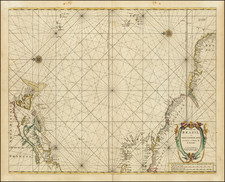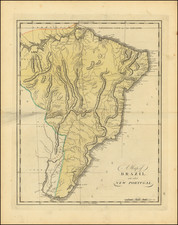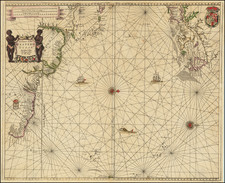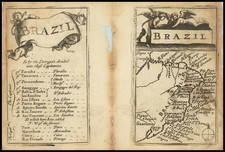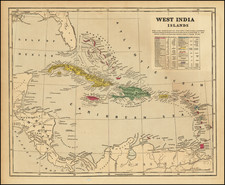Rare Dutch Sea Chart of the Western Atlantic and Approaches To North America
Fine early chart of the Western Atlantic and contiguous parts of the Northeastern US and Northern South America, published by Johannes Van Loon in Amsterdam.
Drawn from the rare work Theunis Jacobsz (circa 1650). this finely executed sea chart assumes the perspective of the westward direction facing downwards and embraces the Western Atlantic Ocean from the Canaries and Azores, in the east, to the eastern reaches of the American continents. It features North America from Cape May up to and including Newfoundland, the West Indies from Hispaniola through to the Barbados, and South America from eastern Colombia through to Pernambuco, Brazil.
As noted by Burden, Van Loon introduces English nomenclature, including replacing New Amsterdam with Manhates (Manhattan). Stamford and Nieu haven are shown, as are Pleymouth, Briston (Bristol) and Baston (Boston).
Cartographically, the depiction of the Mid-Atlantic region, New England and eastern Canada is novel and distinct. The depiction of the American coasts running from Cape May to Cape Cod departs from the portrayal commonly used on contemporary Dutch charts that were largely derived from Adiaen Block's maps of 1614. On the present chart, Long Island is more correctly shown to have an elongated (as opposed to bulbous) form, while Narragansett Bay is shown to correctly open to the south (whereas the Block maps show the mouth of the bay to be sheltered by an island).
Further south, the depiction of the eastern Caribbean is relatively conventional for the time, and shows the WIC's direct experience in the region, having recently settled a number of islands, including Curaçao and Saint Martin. The coasts of South America prominently feature the mouths of the Amazon and Orinoco rivers. The mapping of Northeastern Brazil is derived from Dutch West India Company maps disseminated by Caspar Barlaeus during the recent Dutch hegemony over the region (the Portuguese only managed to evict the Dutch from the region in 1654).
Rarity
The map is very rare on the market. We note no appearances in AMPR in the past 40 years and only 1 auction record in the same time period (this example).









